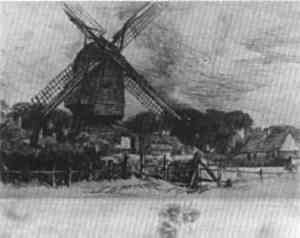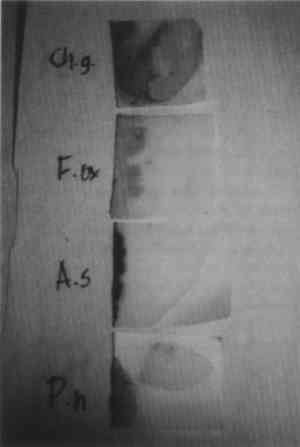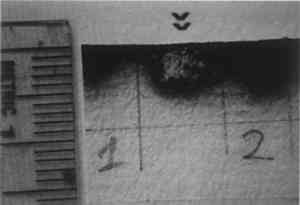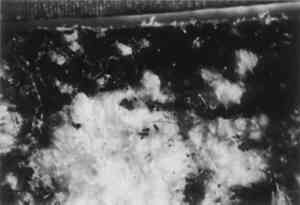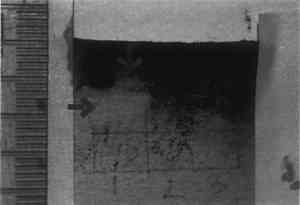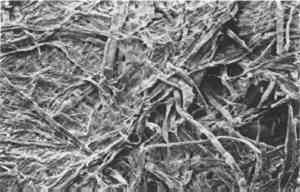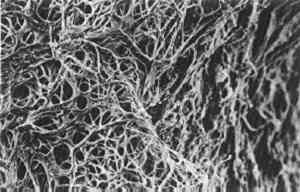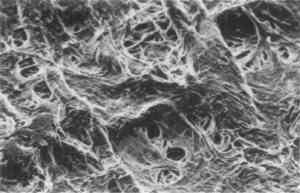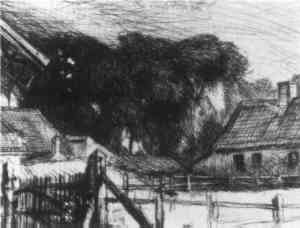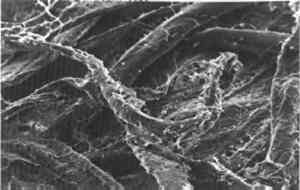LASER STAIN REMOVAL OF FUNGUS-INDUCED STAINS FROM PAPERHANNA MARIA SZCZEPANOWSKA, & WILLIAM R. MOOMAW
ABSTRACT—Artworks and other documents on paper often suffer damage from the growth of several species of fungi. These fungi appear to utilize trace mineral elements in the paper for their metabolism and gradually consume the paper itself as a carbon source. In the process, they often produce stains on paper that may arise from colored, organic metabolic waste products, or the fungus may convert colorless metal ions in the paper into visible stains, as occurs in foxing. Sometimes the observed stain is that of the colored fungal bodies themselves. In this paper, we will report on the effectiveness of the intense light from a powerful laser to remove fungus-produced stains from prints, drawings, and artworks executed on paper. In some favorable cases, the fungal mycelia that penetrate the paper were removed along with the stain. Examination of successfully treated areas by both optical and electron microscopy reveals little or no damage to the surface or structure of the paper support following laser cleaning. Care must be exercised to avoid burning the paper with the laser beam or removing ink or pigment from the artwork itself. When used appropriately, laser removal of fungal stains and residue appears to have considerable potential for nondestructive conservation of works on paper. 1 INTRODUCTIONFungi are known to damage artworks on paper in two principal ways. First they utilize the paper cellulose as a carbon source, weakening and eventually destroying the paper fibers. Fungi also need the trace metals found in the paper or often in the inks of the artwork. The most obvious manifestations of damage are the multihued, fungal-induced stains that mar many works. These stains may arise from colored fungal bodies or, more commonly, from their metabolic waste products that generate and bind tightly to the paper fibers. In other cases, such as foxing, fungal metabolism changes the oxidation state of trace metals, such as iron, which are already present in the paper, to produce colored stains from colorless forms. While the fungal stains can sometimes be extracted with appropriate solvents, there are few effective solvents that do not dissolve the ink or damage the paper fibers, and many stains resist solvent extraction entirely. Developing new solvent systems is time consuming and requires a great deal of trial and error, since the chemical structure of the pigment stains is not generally known (Szczepanowska and Lovett 1992). Mechanical stain removal is also problematic in that it is not selective between ink and stain; often produces abrasion of the paper fibers, markedly deteriorating the art work; and is extraordinarily tedious. For these reasons, we decided to examine an alternative physical technique that might be more specific and flexible. Lasers, unlike conventional light sources, produce a monochromatic pencil-like beam of intense light that is capable of vaporizing colored materials. If the stain or pigment absorbs the laser light more effectively than the substrate, it should be possible to remove the pigment while leaving the substrate undamaged. Research scientists have used this technique to remove adsorbed substances from surfaces, and doctors have successfully removed birthmarks and tattoos nonsurgically with lasers (Lawrence 1986; Muncheryan 1979). To our knowledge, no one has used lasers successfully to remove stains from paper.Barger (1991) experimented with lasers to clean 2 TREATMENT METHODFour strains of fungi commonly encountered on artworks on paper were selected for the experiment. Each of the fungi is characterized by the production of different colored stains. Fungus Alternaria solani produces a dense black stain, Fusarium oxysporum a pinkish stain, Penicillium notatum a light green stain, and Chaetomium globosum a brownish gray stain. The first three listed fungi were cultured on potato-dextrose agar medium; Chaetomium globosum was cultured on V-8 juice–agar medium. Fungal stains were secreted to the paper samples placed in individual Petri dishes (see Szczepanowska and Lovett 1992). Wove paper of medium weight, manufactured by Rives and Arches, was selected for the experiments. Cultivation of fungi and production of stains were carried out in an optimal environment, at a pH of 6 at 24�C and with exposure to the light from a standard fluorescent lamp for 8 hours per day for 21 days. This technique produced dark stains that appear identical to those found on paper documents and works of art (fig. 1). In addition to the stains induced on paper samples, dark stains on actual artworks were also treated in these studies. Prominent, dark staining is found on the margins of a 19th-century Flemish etching by M. L. Morcari (fig. 1). Although there was no fungal residue that would allow us to identify the fungus left on the artwork, based on the color and pattern, the species most likely responsible for the stain is Alternaria solani.
Each stain was photographed before and after exposure to laser light using a Cannon A1 camera with a macro lens FD 50mm 1:35 and 35mm Kodachrome daylight film, 400 ASA. Examples of the four types of induced stains are shown in figure 2 prior to treatment. The treated stains were also examined under magnifications of 30–60x using a Wild Heerbrugg binocular microscope and photographed with a Nikon N200 camera using 160 ASA Ekta-chrome tungsten film with a light source Intralux 250HL, Volpi AG. Comparison of Alternaria stains with laser-treated areas under increasing optical magnification is illustrated in figure 3. The effect of laser treatment on the fungal residue and paper structure was determined by scanning electron microscopy using a model 100 Cambridge Stereo scanner at magnifications of 500–3000x (see figs. 4–6).
The intense green light, at a wavelength of 532 nm from a Quantel model YG580 neodymium YAG pulsed laser, was aimed at a Typical average power for the YAG laser was about 1.6 watts. The dye laser used Rhodamine 6G as the lasing dye, with a maximum measured average power output of 0.26 watts at 566 nm. With the high powers of the YAG laser, burning of the paper was found to occur if the repetition rate exceeded 10 pulses per second for 1.5 seconds. Focusing the beam with a lens also increased the power density to the point that burning and other damage was observed. The unfocused beam of the YAG laser typically cleaned a small circle of stain about 4 mm in diameter. It is strongly recommended that treatment begin at low power and slow pulse frequencies, utilizing the minimum laser beam intensity that is effective in order to avoid damage to the ink or paper. 3 RESULTS OF LASER TREATMENT OF FUNGAL STAINSAt the appropriate laser power and pulse frequency, YAG laser treatment at 532 nm was very effective in removing the stains associated with two of the four fungi studied, Alternaria solani(figs. 3a–b) and Penicillium notatum(fig. 3c). In both of these cases, the stains were completely removed after 3 to 10 laser pulses. Inspection under both the light microscope (fig. 3) and at higher power using the scanning electron microscope (fig. 4b) revealed no damage to the paper fibers in the treated area. The stains associated with Chaetomium globosum and Fusarium oxysporum appeared to be unaffected by the laser treatment.
What was truly remarkable was the discovery that in the case of Penicillium notatum, the fungal bodies embedded in the paper matrix were removed along with the stain.Figure 4a clearly reveals the fungal spores in a scanning electron micrograph, and figure 4b shows the intact paper fibers and absence of fungal bodies after treatment. The lower power levels of the dye laser were generally found to be less effective in removing stains, but successful dye laser removal of Fusarium fungal bodies was achieved at these power levels after 3 minutes of pulsing at 20 pulses per second (fig. 6b). Additional optimization studies are needed. Chaetomium globusum is a highly cellulolytic fungus that utilizes cellulose fibers as a carbon nutrient source, turning pliable paper into a pulpy form with a porous, blotterlike structure of low tear strength. With sufficient time and favorable conditions, all cellulose fibers are digested.Figure 5 illustrates Chaetomium globusum–damaged paper. Because of the fundamental damage to the fibers by this fungus, any type of mechanical treatment on the affected area will only cause further rearrangement and deterioration of the paper fibers. Unfortunately, laser treatment under the conditions we used did not appear to be effective in removing Chaetomium stains.
In the case of Fusarium oxysporum, laser treatment did not appear to remove stains successfully, but the scanning electron microscope revealed that small holes approximately 5–10 μm in diameter were produced (fig. 6). The holes appear to be where the mycelium or fungal bodies penetrated the structure of the paper and are the voids left behind when the mycelium is removed by the laser light rather than produced by the laser itself. Otherwise
The technique was tested on a print (fig. 1) that had been stained most likely by fungus Alternaria solani. The print was a 19th-century Flemish etching printed on medium-weight wove paper. It was possible to remove considerable amounts of the stain with only 1 to 6 laser pulses without degrading the quality of the paper itself (fig. 7).
To determine possible damage to ink and other pigments, the YAG laser was aimed at an area of heavy black printer's ink on the Flemish print. Thirty pulses at the highest average laser power (1.6 watts) were required to remove a noticeable amount of ink (fig. 8). This number of high-energy pulses is 6 to 10 times higher than that needed to remove fungal stains. Similar power levels were also capable of removing pastel pigment from another piece of paper, but loss of pigment was insignificant when power levels were lowered by 75%.
4 UNDERSTANDING THE MECHANISM OF LASER STAIN REMOVALBased on the work carried out to date, it appears that the light from the laser is absorbed by the stain to produce intense local heating within the stain, ink, or pigment and vaporize them from the paper fibers. If all the heat is absorbed in the vaporization process, then no damage occurs to the paper fibers. Burning of the paper seems to occur when the rate of heat dissipation is not rapid enough to offset the rate of energy absorption from the laser. Slowing the repetition rate to less than two or three pulses per second for the power levels we employed seems to solve the problem, but one may have to consider additional factors, such as the color of the stain and the wavelength of the laser light, in determining optimal conditions. This finding suggests that one might be able to optimize the effectiveness of stain removal by selecting a laser wavelength that is strongly absorbed by the stain or by choosing a wavelength that is more strongly absorbed by the stain than the ink to be protected in the artwork. The proposed mechanism is also consistent with the observation that two of the stains, purple and brown, were not removed by the laser light. Neither stain effectively absorbs the green light of the laser. Future work could involve some wavelength-dependent studies using both the YAG laser and the dye laser to determine optimal wavelengths for particular stains. The disappearance of the fungal bodies may also be occurring by instantaneous heating by the laser as well. On occasion, looking through an appropriate eye-protecting optical filter that blocked the laser light, one could actually observe small clouds of fine particles, which might be the fungus, leaving the surface of the paper. The completeness with which the fungus is removed and the lack of damage to the paper is truly remarkable (fig. 4). Removal is far superior to any mechanical or solvent methods that have been tried to date.
5 CONCLUSIONSThis work demonstrates that laser stain removal has significant advantages for removing stains from artwork on paper. When carried out at appropriate power levels, the laser-cleaned areas appeared indistinguishable from untreated, stain-free sections of the paper. We did not test the mechanical properties of the paper after exposure to the laser, but there was no effect on the appearance of the fibers and their arrangement. Examination of the fibers under high magnification substantiates the lack of damage. Because visible light rather than ultraviolet light is used, there is little risk that photo-induced aging will occur from laser treatment. Based on these experiments, it should be possible to clean 1 sq cm of stain in a minute or two, provided that an effective mechanism for 6 HEALTH AND SAFETY DATAConservators who plan to utilize laser stain removal (LSR) should always wear appropriate eye protection in the form of laser blocking goggles to prevent reflected or direct exposure of the laser light from entering one's eye. Laser light at the intensities utilized in these studies will cause instantaneous, irreversible blindness. ACKNOWLEDGEMENTSWe wish to acknowledge the assistance of assistant professor J. W. Thoman, Jr., of the Williams College Chemistry Department for making the laser in his laboratory available to us and for his assistance in several of the experiments. We also wish to thank Nancy Piatszyc, electron microscope technician at the Williams College Bronfman Science Center, for her guidance and assistance with the electron microscopy, and Michael Heslip, painting conservator, Williamstown Regional Art Conservation Laboratory, Williamstown, Massachusetts, for kindly donating the artwork used in this study. REFERENCES
Asmus, J. F.1978. Properties of laser-cleaned Carrara marble surfaces. Geological Society of America.81–88. Asmus, J. F.1986. More light to art conservation. Circuits and Devices Magazine2:6–15. Asmus, J. F., G.Guattari, L.Lazzarini, G.Musumeci, and R. F.Wuerker. 1973. Holography in the conservation of statuary. Studies in Conservation18:49–63. Barger, S.1991. Personal communciation. Private conservator, Santa Fe, N. M. Lawrence, C. L.1986. The laser book: A new technology of light.New York: Prentice-Hall. Muncheryan, H. M.1979. Laser technology.Indianapolis: Howard W. Sams. Szczepanowska, H., and C.Lovett, Jr. 1992. A study of the removal and prevention of fungal stains on paper. Journal of the American Institute for Conservation31:147–60. Vitkus, J. R., and J. F.Asmus. 1976. Treatment of leather and vellum with transient heating. AIC preprints, 4th Annual Meeting, American Institute for Conservation, Washington, D.C.111–17. AUTHOR INFORMATIONHANNA MARIA SZCZEPANOWSKA is a conservator of works of art on paper and parchment. She received her master's degree from the University of Nicolaus Copernicus in Torun, Poland, in 1978. The research described in this paper was carried out when she was at the New York Office of Parks, Recreation, and Historic Preservation, Bureau of Historic Sites, Peebles Island, Waterford, New York. In 1988 and 1990 she received grants from the Fulbright Foundation and the Samuel H. Kress Foundation to work as a conservator and consultant for the collection of the Knights of Malta and the collection of prints and old master drawings at the Cathedral Museum in Mdina, Malta. From 1992 to 1993 she served as paper conservator at the United States Holocaust Memorial Museum, Washington, D.C. Address: 728 S. Wolfe St., Baltimore, Md. 21231. WILLIAM R. MOOMAW is a research chemist and professor and director of the International Environment and Resource Policy Program at the Fletcher School of Law and Diplomacy. The research described in this paper was carried out when he was professor of chemistry at Williams College, Williamstown, Massachusetts. Address: Fletcher School of Law and Diplomacy, Tufts University, Medford, Mass. 02155.
 Section Index Section Index |
